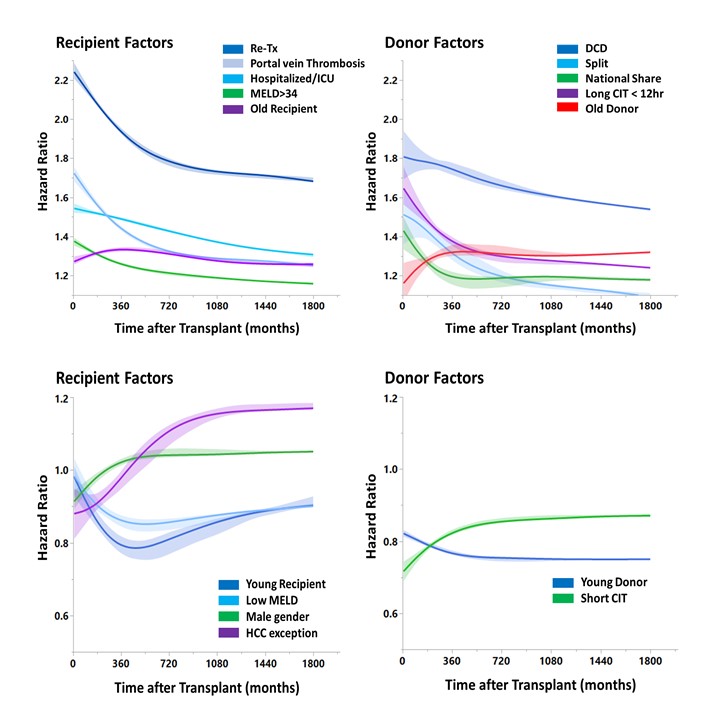The Risks Are Not Always The Same; Peak Timing Of Risk In Liver Transplantation
Cleveland Clinic, Cleveland, OH
Meeting: 2019 American Transplant Congress
Abstract number: A302
Keywords: Risk factors
Session Information
Session Name: Poster Session A: Liver: Recipient Selection
Session Type: Poster Session
Date: Saturday, June 1, 2019
Session Time: 5:30pm-7:30pm
 Presentation Time: 5:30pm-7:30pm
Presentation Time: 5:30pm-7:30pm
Location: Hall C & D
*Purpose: Numerous risk factors are known to affect liver transplantation (LT). Previous studies suggest that a combination of favorable and unfavorable factors is essential in donor and recipient selection assessed by hazard ratios (HR) from Cox regression model. However, the HR is not always the same through time and peak patterns are different in each risk factors. The aim of this study was to investigate longitudinal changes of HR in well-known risk/favorable factors to find the best donor-recipient combination.
*Methods: This study identified 80,520 adult patients who had deceased donor LT in the scientific registry of transplant recipients (SRTR) from 2002-2017. We evaluated changes of HRs according to time from surgery using Cox regression model in 14 well-known favorable/unfavorable prognostic factors. Factors included, young/old recipient age, re-transplant, portal vein thrombosis, high (>34)/low (<18) MELD, exception for hepatocellular carcinoma (HCC), young/old donor, donor after circulation death (DCD), split liver, national share, and short/long cold ischemic time.
*Results: The chronological changes in HRs according to the time from LT in each factor were shown in Figures. Most risk factors had the highest HR in the very early period after LT and reached to plateau after two years. DCD and split LT showed unique HR patterns. DCD maintained a high HR long after LT, whereas split LT demonstrated a continuously decreasing HR even after two years from LT. The HR curve for graft loss in HCC patients was favorable in the early phase and gradually increased as tumor recurrence became more common.
*Conclusions: The favorable/unfavorable factors affecting LT are not static but dynamic from the time from surgery. The timing of peak risk for various prognostic factors helps surgeons determine the best combination of donor-recipient matching.
To cite this abstract in AMA style:
Sasaki K, McVey J, Firl D, Okubo K, Fujiki M, Uso TDiago, Kwon D, Eghtesad B, Quintini C, Miller C, Aucejo F, Hasimoto K. The Risks Are Not Always The Same; Peak Timing Of Risk In Liver Transplantation [abstract]. Am J Transplant. 2019; 19 (suppl 3). https://atcmeetingabstracts.com/abstract/the-risks-are-not-always-the-same-peak-timing-of-risk-in-liver-transplantation/. Accessed January 1, 2026.« Back to 2019 American Transplant Congress

